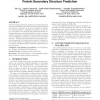1653 search results - page 64 / 331 » Adversarial Sequence Prediction |
BIOINFORMATICS
2010
13 years 9 months ago
2010
Motivation: Existing methods for protein sequence analysis are generally firstorder and inherently assume that each position is independent. We develop a general framework for int...
SIGIR
2004
ACM
14 years 3 months ago
2004
ACM
Protein secondary structure prediction is an important step towards understanding the relation between protein sequence and structure. However, most current prediction methods use...
BMCBI
2006
13 years 9 months ago
2006
Background: Predicting residues' contacts using primary amino acid sequence alone is an important task that can guide 3D structure modeling and can verify the quality of the ...
ACL
2009
13 years 7 months ago
2009
Correct stress placement is important in text-to-speech systems, in terms of both the overall accuracy and the naturalness of pronunciation. In this paper, we formulate stress ass...
GCB
1998
Springer
14 years 1 months ago
1998
Springer
The leucine zipper is a dimerization domain occurring mostly in regulatory and thus in many oncogenic proteins. The leucine repeat in the sequence has been traditionally used for ...

